With thanks to Robin Longbottom who compiled this article.
When I saw the enquiry on the Forum asking for
information about Sutton House I decided to dig out information that I had
gathered some years back on the property's history. Unfortunately it was
scattered throughout various files and has taken me a little longer to put
together than I had hoped.
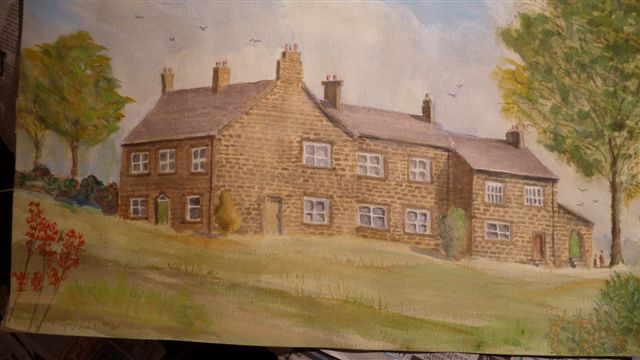
Painting of Sutton House by the late Mr Bryan Gill
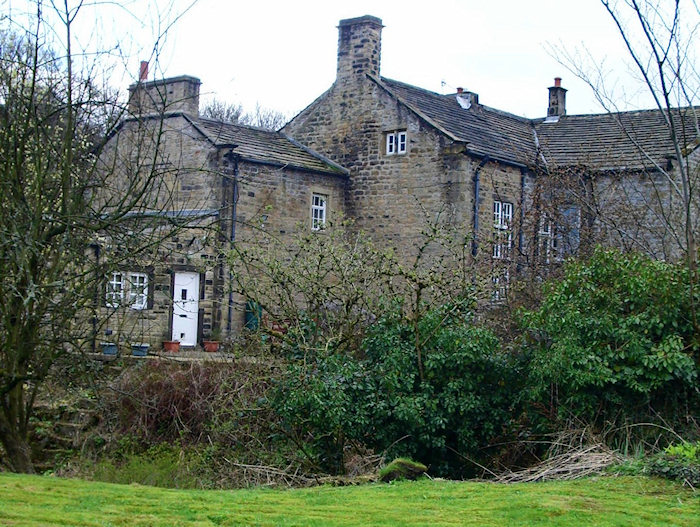
Sutton House from the Ellers side. Photo Alan Pickles.
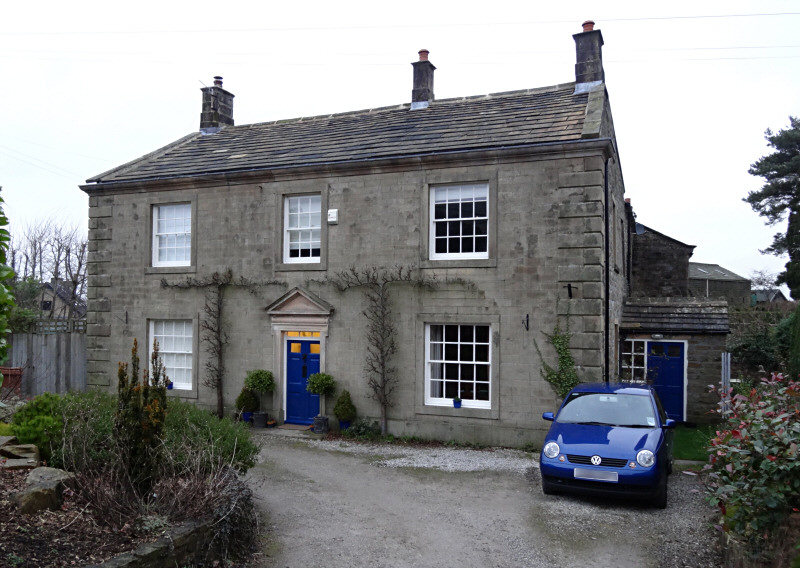
Sutton House from the front. Photo Robin Longbottom.
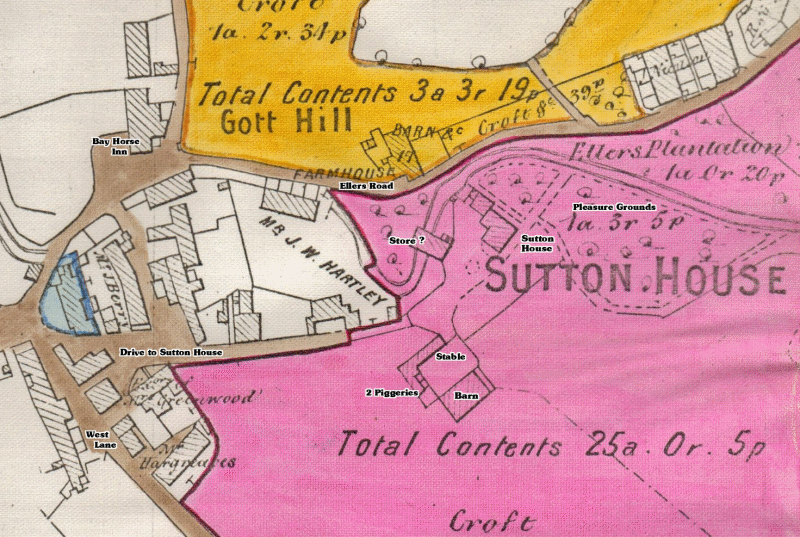
Sutton House Estate 1892
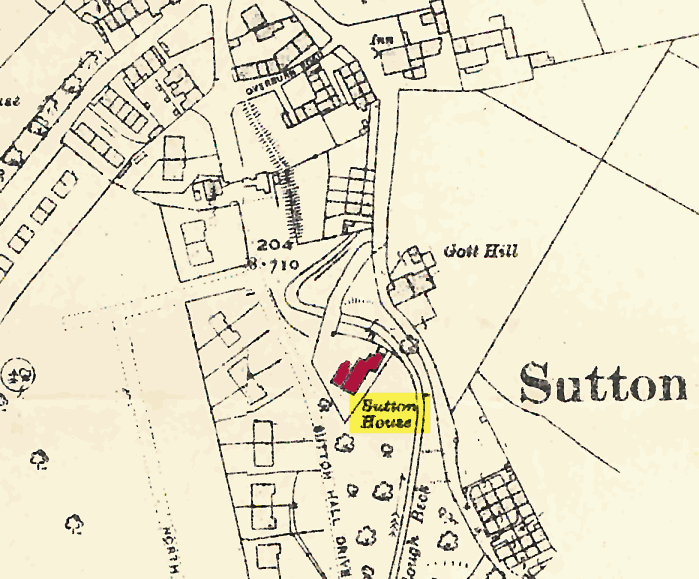
1938 map
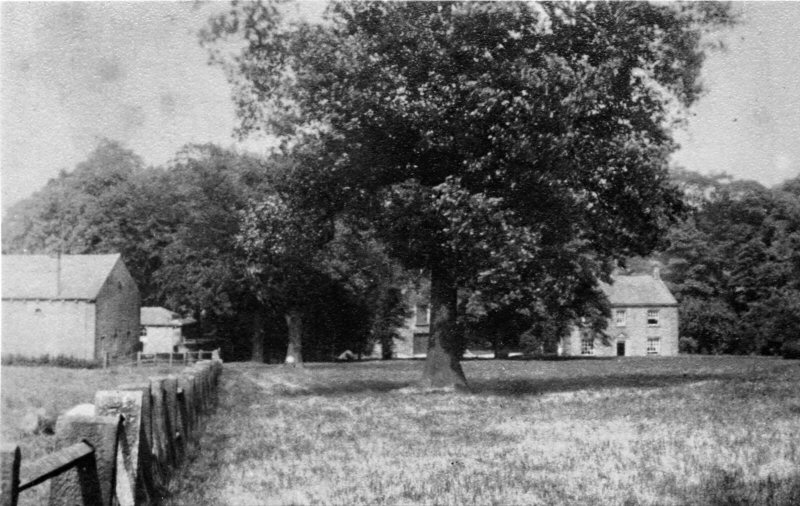
Sutton House from the Glynn Whiteoak collection. On the extreme left are the barn and part of the stable block,
almost central in the trees a two storey building that once spanned the beck and the base of which now serves
as a bridge. The house is to the right of it with its original Georgian sash windows. The buildings and the
fence with stone posts correspond to the plan of 1892.
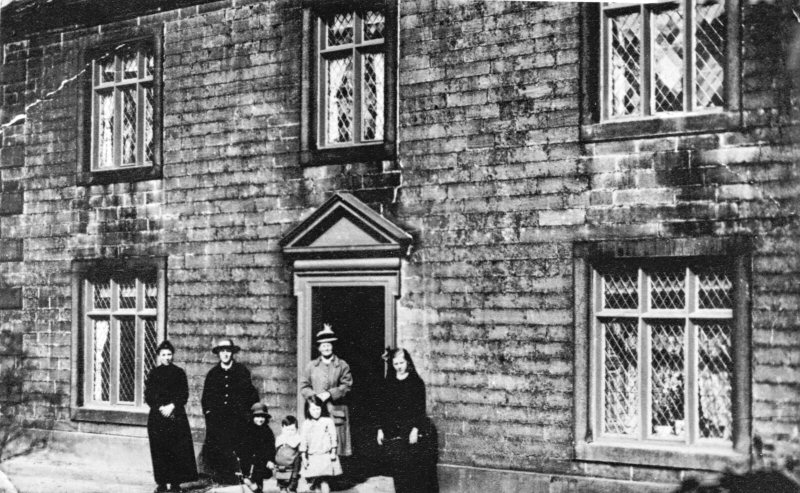
Sutton House early 1900s, from the Glynn Whiteoak collection
I first saw the house as a boy when I walked
passed it with Fred Pye (from whom I got my interest in the village's history),
who showed me the date stone of 1647 and old mullioned windows in the
side elevation. After the sale of the 'Georgian' part of the house in the early
1970s I had the opportunity to look around prior to the completion of the
renovation work. I was impressed by the two arched fireplaces and an ornate
plaster ceiling above the staircase and some years after my visit decided to
do a little research into the history of the house.
The Yeoman's House
When Richard Dixon of Sutton House died in 1708 his widow, Isabel, was left
to deal with his estate. He had not made a will and none of his children were
of age, so the administration of his estate was in Isabel's hands. Prior to 1858
wills and intestacies were processed by ecclesiastical courts and during this
period ecclesiastical law required an inventory to be made of all the deceased
person's possessions. We are fortunate that the inventory for Richard Dixon
has survived, as the list of his household effects and goods enables us to get
a picture of how the dwelling stood at that time.
We know that Sutton House dates back at least as far as the first half of the
17th century as it has a date stone for 1647 on the western elevation, and it
also retains features that are contemporary with this period. Furthermore, it is
likely that a house existed on this site well before the date stone, which may
have been introduced to mark the marriage of Richard's parents, Richard and
Elizabeth Dixon (whose initials also appear on the stone). Richard was 36
years old when he married Isabel Garforth in 1684 and she was aged about
sixteen. Isabel was a daughter of William Garforth, whose family resided at
Steeton Hall, Steeton, and the union appears to have brought benefits in the
form of land and property in Steeton (later documents show that the Dixon
family owned a number of properties in the village). Richard and Isabel had
a number of children including John (born 1692) and Edward who was born
the year of his father's death. Isabel proved to be an able woman and kept
her husband's estate in good order. She was without doubt highly regarded
in the locality and when she died in 1737 the cleric made a note alongside the
entry for her burial, the accolade .. Mother of the Family.
The inventory of Richard Dixon's .. Goods Chattles and Cattles ..
conveniently identifies the various rooms in the house and gives us some
indication of the layout of the dwelling and how those rooms were used. The
principal living room is referred to as the housebody and was probably the
room to the left of the present front entrance. This is most likely to have been
the room with the large segmental fireplace that still exists, now in a much
smaller room. In 1708 the fireplace was complete with ..
One Rainge One
iron bakstone & other materialls belonging them.
It was in this room that the
main business of the household took place and where the main meals were
cooked and eaten on ..
One Long Table with Two formes.
Here the staple flat
bread of the Pennine area, oatcake or havercake, was cooked on the ..
bakstone .. or bakestone, and hung up on .. Two bread fleakes .. suspended
from the ceiling. This is the room into which guests would have been shown
and where the family displayed some of their wealth in the form of .. pewter ..
(to the value of £3 - 16s - 0d) on .. four Ash Shealves. The room also
contained .. One Wood Clock, One Cupboard, Two Long Chaires, One
Square Table, Seven Chaires .. and items .. In Brass Tin & Iron.
The next room of importance was the Sun Parlour, possibly the room to the
right of the present front elevation, which still retains a smaller arched
fireplace. As this was the only other heated living room it was undoubtedly
Richard and Isabella's chamber and was furnished with their .. bed with
bedding & hangings belonging. The room also contained .. One ovell Table,
Ten Chaires, One Foot Chist & Two Buffetts, and expensive items of .. Glass,
Tin & White Plate. The presence of ten chairs and a table indicates that it
was not only a bedroom, but that it was also used as a more intimate family
room for private dining and relaxation.
To the rear of these two principal rooms were the Little Parlour and the Low
Parlour. The Little Parlour contained .. Two Bedds with bedding, Two little
Tables .. and .. one Close (clothes) Box, this was probably where the boys
slept. This room was to the rear of the housebody. The Lower Parlour, to the
rear of the Sun Parlour, was furnished with .. One Square table, one chist,
one pewter (item). Built onto the back of the main house and behind the
Lower Parlour was a Milkhouse & buttery and a kitchen. The Milkhouse &
buttery contained .. Two Shelves, One Gantrey & One Barrell. It was here
that the milk from Richard's 'ffive cows' was stored and probably processed
into butter and cheese, and also where beer, the staple household drink, was
brewed and stored in the barrell on the gantrey (barrel stand). The name
buttery had nothing to do with dairy produce and was actually from the old
word 'butt' for a barrell and associated with beer and drink, in larger houses
the servant in charge of the buttery was called the butler. Adjoining the
milkhouse and buttery was the last room on the ground floor, the Kitchen,
which indicates that the Dixon's were gradually moving the cooking of food
out of the main housebody and into a separate room. Separate kitchens in
yeoman houses had come into vogue during the 17th century, but although
the Dixon's had added a kitchen, with .. One Iron Rainge, one Iron pott & one
Brasse Pott, they were still clearly preparing the major part of their food in the
main housebody with its range, bakestone and bread flakes (also known as
creels).
In addition to the ground floor rooms there may also have been a corridor
separating the rooms in the main house with the staircase leading to the
upper rooms. The first upper room listed is the Chamber over the
house(body), this was sparsely furnished with .. One bed with beding,
together with .. Three Chists, Two kists and one Chair .. , and may have been
the room occupied by Richard and Isabella's daughters. In contrast the room
Over the Sun Parlour contained .. One Bed with beding & hangings, Two
Chists, One ovall Table, four chaires, One Trunk, one box, Two Buffetts, one
round table.. and some .. Linnen. This room may have been reserved as a
guest room and also served as a storeroom for the household linen, to which
Isabel would have needed constant access. There were two further upstairs
rooms, the Chamber over the Lower Parlour, Milkhouse & buttery, which was
unoccupied and probably used for the storage of general household items,
often referred to as hustlement. This room was furnished with .. One
Dishboard, One Cupboard & one foot chist. The last room was the Chamber
over the Kitchen, with .. One bed with beding, one desk, one chist .. and ..
one Coffer .., this was probably occupied by the servant or servants.
The house also had a separate barn and stables. The inventory lists the stock
in the barn .. Ffive cows, One Drinking Calfe, one heiffer, five other Small
Cattle (the word cattle was a general term and these Small Cattle may well
have been pigs or goats), there was also a store of .. hay, straw & corne ..
together with .. Carts & wheels & other Husbandry Geare. The last building
was the stable, which housed .. Two Maires, one Gelding with furniture
(harness, pack saddles etc) and .. One fole and one Stagg (presumably a
stallion housed away from the mares).
The layout of the house was typical of many yeomen's houses in the West
Riding, the main structure having two rooms along a principal elevation, each
of which had two smaller rooms to the rear. The lower parlour had a service
room at the back in the form of the milkhouse and buttery through which the
kitchen was accessed.
Richard and Isabella's eldest son, John, eventually inherited his father's
estate. He married Martha Bawdwen, the Bawdwen family lived at Carr
Head, Cowling and at Stonegappe, in Glusburn. Like his father he appears to
have married late in life, he was aged about 41 and his wife was aged 19. As
part of the marriage settlement John Dixon acquired property in Glusburn and
for some years after their marriage in 1733 the couple resided at Carr Head,
before moving to Sutton House in about 1743. We do not know the reason
for his delay in moving into the family home, his mother had died in 1737 and
there may have been other family members still residing in the house or it
may have been let and bringing in a good income. John and Martha had two
sons who survived into adulthood, William (born 1744, baptised 1745) and
Edmund (born 1746) and one daughter, Mary (born 1737). John's wife died
in 1748 and he died nine years later. At his death he is described as a
Gentleman of Sutton and his will, which was proved on 12 November 1757,
gives some idea to the size of his estate :- he left to his eldest son ... all
those Messuages (houses) and Tenements within the Township of Sutton ...
together with all the Lands, Closes, premises ..... and also that piece or
parcel of Land lying within Eastburn. To his son Edmund he left ...
all my Messuages and Tenements within the Township of Steeton ... with all and
singular the Lands, Closes, Grounds, Premises .... & also all my Messuages,
Cottages, Lands, Tenements ... in Glusburn. To his daughter, Mary, he left
the sum of £400, about £600,000 in today's terms. Unfortunately no
inventory has survived.
When John Dixon died his eldest son was only twelve years old and therefore
the ecclesiastical court would have appointed trustees to manage the estate
and ensure that any legacies were paid out. William, John's eldest son,
inherited Sutton House and when he came of age he married Elizabeth
(Betty) Starkie at Keighley in April 1765 he is recorded as .. of the Parish of
Kildwick Gentleman. They raised three girls, Farrington, Martha Frances, and
Elizabeth and one boy, William Starkie Dixon, who was born in 1776, but died
in his early twenties. A deed of 1773 shows that William Dixon owned at least
seven properties in Sutton, together with a considerable acreage of land.
However, in the mid 1770's he appears to have found himself in financial
difficulty and either sold Sutton House or lost it as a consequence of failing to
meet obligations under a loan agreement or mortgage.
The Gentleman's House
The new owner of Sutton House was Robert Harper, a confectioner of New
Bond Street, London. Robert Harper was born in Keighley in 1716 and was
the son of Richard Harper, a yeoman, who owned property and land in
Sutton. Robert inherited his father's property in Sutton and he may well have
acquired Sutton House with the idea of retiring there from London. Whatever
his intentions were, he died within a year or two of coming into possession of
the property and as he had no family of his own, he left his estate to his
nephew Robert Walters. It is not clear where the Walters family originated
from, but Robert had received some education and was literate. He was the
son of Robert Harper's sister, Elizabeth Harper and her husband William
Walters, and at the time he came into his inheritance he was a shalloon
maker (worsted cloth) in Sutton. He married Mary Heaton, the daughter of
John Heaton, a yeoman, of Sutton and following receipt of his inheritance he
quickly raised his status to that of gentleman, changed his name to Robert
Walters Harper and moved into Sutton House.
Robert Walters Harper is the most likely candidate for making the substantial
alterations that changed the house from a 17th century dwelling in to the
'Capital Mansion House' that is described in a deed of 1790. The Harper's
later financial commitments and problems would seem to discount the work
having taken place later than the 1780's. Whoever made the alterations, the
old principal elevation was torn down and replaced by a new ashlar stone
front with sash windows and a central doorway surmounted by a classical
pediment. The old internal structure was ripped out with the exception of the
two fireplaces and chimney breasts. A central hallway now led to a new
grand staircase above which was a fine plaster ceiling. This ceiling was a
Robert Adam design, an oval within a rectangle, and much in vogue during
the latter half of the 18th century, unfortunately it was lost during renovations
to the property in the 1970's. The ceilings of both lower and upper rooms
appear to have been raised and the house was re-roofed. However, the back
portion of the house still remained that of a 17th century dwelling, whilst the
new front gave the house the appearance of a fine Georgian residence.
There were other more subtle changes to the house, such as moving all the
sleeping accommodation upstairs, preparing and cooking all the food in the
kitchen and discarding the milkhouse and buttery, which gave way to a wine
cellar and to the tea caddy.
Robert Walters Harper's first child, was a son born in 1782, and also named
Robert Walters Harper, a second child, Jane, was born in 1784 following
which his wife, Mary, died. Harper remarried in 1785 to Martha Slack of
Glusburn and had four further children, Richard, born 1786, John born 1788,
Robinson born 1789 (died 1795) and William born 1791. It appears that the
Harper's were now spending a considerable amount of time away from the
village, perhaps in London and by 1789 Robert Walters Harper had let Sutton
House to John Smyth (possibly John Smith of Sutton, a successful fellmonger
and tawer - dress leather manufacturer), at a yearly rental of £52 - 10
shillings. He also mortgaged the house and lands in 1790, possibly to raise
money to build a speculative cotton mill on his land adjoining Sutton Beck at
Greenroyd. The mill was erected in 1791, but initially struggled to get a
tenant, and it was not until 1793 that it was occupied. Speculating in the
cotton trade brought riches for many investors, but was also the down fall of
many others and Robert Walters Harper and his eldest son came seriously
adrift in 1805 and both were declared bankrupt.
Somewhat surprisingly William Dixon is recorded in 1807 as residing once
more at Sutton House, but by this time his daughters were married and his
only son had died. He did not enjoy his residency long and the burial of ..
William Dixon of Sutton a gentleman aged 64 years .. was recorded at
Kildwick on 23 March 1808, his wife Elizabeth died sixteen years later in
1824.
Whether or not the house was still in the ownership of the Harpers or had
been purchased back by William Dixon remains unknown at present.
Whatever the case it did not remain in either family and was acquired by
Joseph Heaton (bapt. 1779), the son of Robert Heaton of Aden in Sutton.
Joseph was a successful worsted stuff manufacturer and may have bought
the house at the time of his marriage in 1820 to Susannah Sutcliffe, the
daughter of a wealthy Heptonstall family.
By 1840 Joseph Heaton was retired from business and living at Sutton House
together with his wife, his only son Robert (born 1823) and two servants. At
this time Joseph had a considerable interest in the village, owning seven
houses, a number of cottages and over 200 acres of land (nearly all of which
was occupied by tenants).
The census of 1851 reveals that Joseph's son, Robert Heaton, was a worsted
manufacturer employing, 72 men, 124 women, 19 boys and 43 girls at his mill
in Silsden. He was unmarried and still living with his elderly parents at Sutton
House. Joseph Heaton died in 1854 and his wife, Susannah, two years later
and when Robert himself died unmarried on 25 April 1863 he left his entire
estate, valued at £7,000 (about £4 million in today's money), to his cousin,
John Crossley Sutcliffe of Hebden Bridge. Sutcliffe did not take up
occupation of Sutton House, but appears to have left it empty for some years,
apart from a general servant. It was eventually tenanted by Joshua Ramsden
and his family, who farmed some 30 acres in the village and later by Thomas
Green, a wool merchant and farmer.
In 1890 John Crossley Sutcliffe died and left a huge estate, valued at
£374,294 (about a £100m today), to his son, John Sutcliffe. John Sutcliffe
had little interest in his property in Sutton and on 8th January 1892 he sold the
house and land to John William Hartley of Prospect House, Sutton.
The Divided House
It is surprising that John Willie Hartley did not move into Sutton House, it was
a substantial gentleman's residence with extensive grounds, approached
along a private drive (following the route of present day Hall Drive), with a
turning circle for coaches, barns and stabling and substantial servants
quarters. However, he had other plans and his acquisition of the property
was to enable him to create a grand approach to a proposed mansion that
was to be built to the east of West Lane. What is remarkable is that Sutton
House survived at all, as this reclusive bachelor was obsessed with privacy
and had a number of properties knocked down, simply because he thought
they would overlook his new grounds and residence.
The old entrance gate together with the barn and stables, which stood to the
south west of the present archway and lodges, were demolished and a new
entrance to Sutton House was made from Ellers Road. By 1900 it had been
divided into three separate dwellings and was occupied by the families of
Alfred Hargreaves, who was a bookkeeper at Greenroyd Mill, John William
Andrews, a mill clerk and William Smith, gardener, waller and mason.
From the time that the house was divided into three dwellings it had
numerous occupants throughout the early twentieth century. It was
eventually purchased by Frank Rodwell and occupied by members of his
family into the 1970's. The front of the house, with the Georgian ashlar
facing, which had been divided into two houses was sold by public auction at
the Black Horse in Skipton about 1973. It was expected to bring about £2500
to £3000, but if I remember rightly reached £5000 and was the talk of the
village for weeks afterwards.
The current house remains divided into two dwellings, the Georgian house
now having the benefit of a restored access from Hall Drive, whilst the house
to the rear retains the revised access from Ellers Road.
Principal sources:- Borthwick Institute of Historical Research, York - wills and inventories;
West Yorkshire Archive Service - West Riding Registry of Deeds and Sutton Tithe Map;
Yorkshire Parish Register Society - Kildwick Parish Registers; Craven Indexes - family
History Research in Craven; Keighley Reference Library - 1832 Factory Commission
Report; National Archive Service, Kew - wills and probate.
Note:- I would be interested to hear from anyone who has any additional information on
the history of this property or would like to know more about it.
Robin Longbottom December 2012.








